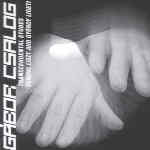Here’s a clever program that juxtaposes some of Liszt’s virtuoso piano etudes with those of Ligeti. Textural commonalities help bridge the 150-year stylistic gap, much as a seasoned DJ concocts segues that seamlessly integrate, say, 1960s classic soul and the latest jungle drum and bass remix. I’m fascinated, for instance, with the way the murmuring ripples of Liszt’s Waldesrauschen provide a smooth, even logical lead into the mallet-like Gamelan evocations that characterize Ligeti’s Galumb borong (Etude No. 7)–or with the manner in which Liszt’s brilliant keyboard adaptation of Paganini’s difficult violin arpeggios (Paganini Etude No. 4) relates to similar “unpianistic” hurdles in the form of Ligeti’s out-of-phase repeated notes (Etude No. 10, “Der Zauberlehrling).
Gábor Csalog’s complete command of this daunting repertoire is in an altogether different league (on a different planet, in fact) than his dry and labored Schubert recital for the same label. There’s tons to admire, from the effortlessly contoured lines in Ligeti’s Automne à Varsovie (slightly faster and more spontaneous than Apollonian perfectionists like Aimard and Ullen) to the full-bodied rhetoric that keeps Liszt’s Ab Irato and Chasse-Neige (Transcendental Etude No. 12) alive and forward moving. At the same time, Csalog does not always voice Ligeti’s polyrhythms with Aimard’s specificity, nor, in the Liszt, does he match Arrau and Bolet’s grandeur and proportion. And the resonant ambience tends to blur rapid, loud passages. But these are minor reservations. Thank goodness that Csalog’s excellent annotations explain what the music sounds like, rather than defend his programming concept–which in any event speaks for itself.
































